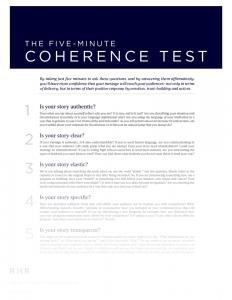The Five-Minute Coherence Test
Do you ever play MadLibs, those fill-in-the-blank narratives that can become zany (or sometimes risqué)? Basically, you’re given a scenario that has empty spaces where you fill in your own details. As an example, here’s one that’s particularly relevant for those of you in higher ed:
You’re about to:
(an action and form of communication such as “send an email/write a letter/publish an article/print a brochure”)
addressed to:
(a significant audience segment such as alumni/parents of current students/prospective first-year students/high school counselors)
that will:
(ask for support of a new initiative/announce an increase in tuition/promote a new academic program/encourage them to send their students to your school).
Sounds familiar right? In fact, it’s a scenario that may be particularly applicable to you right now. Yes, you’ve crafted, proofread, and polished your aforementioned piece. But, before you push the “send” or “print” button or stuff an envelope, you may want to give your communication this five-minute test for coherence. Re-read what you’re about to put out there and ask the following questions:
Is your story authentic?
Does what you say about yourself reflect who you are? Is is true and is it real? Are you describing your situation and circumstances accurately or is your language aspirational only? Are you using the language of your institution in a way that is genuine to you? Is it trustworthy and believable? As you tell parents about an increase in tuition rates, are you truthful about your rationale for the increase or is this just an annual jump that you always do?
Is your story clear?
If your message is authentic, is it also understandable? If you’ve used honest language, are you communicating in a way that your audience will easily grasp what you are saying? Does your story need interpretation? Could your message be misunderstood? If you’re telling high school counselors to send their students, are you articulating the types of students you want them to send? Have you told them what students you do not want them to send your way?
Is your story elastic?
We’re not talking about stretching the truth when we use the word “elastic.” Just the opposite. Elastic refers to the capacity to return to the original shape or size after being stretched. So, if you are introducing something new, say a program or building, does your “stretch” to something new still reflect your mission, core values and vision? Does your communication still reflect your shape? Or does it take you to a place beyond recognition? Are you meeting the needs and interests of your audience in a way that only you and your school can?
Is your story specific?
Have you provided sufficient detail that will enable your audience not to confuse you with competitors? What differentiating features, benefits, rationale or consequence have you included in your communication that will compel your audience to respond? If you are introducing a new program, for example, have you illustrated how your new program outperforms those offered by your competitors? Is it unique to you? If any other school offers the program, how does yours stand out as superior? Details!
Is your story transparent?
This might be the toughest question to answer. Perhaps another question might be to ask, “What information are you holding back?” or “What aren’t you saying?” And follow that with: “Why?” No one wants to say too much. You don’t want to inundate your audience, that is certain. But if your audience isn’t clear about your intentions or motives, or if there’s any doubt cast by your appeal, it’s likely you will not see the results you are seeking. Are you being open about your need, opportunity, request for assistance? Are you building confidence in what you are communicating?
By taking just five minutes to ask these questions, and by answering them affirmatively, you’ll have more confidence that your message will reach your audiences—not only in terms of delivery, but in terms of their positive response by emotion, trust-building and action.


